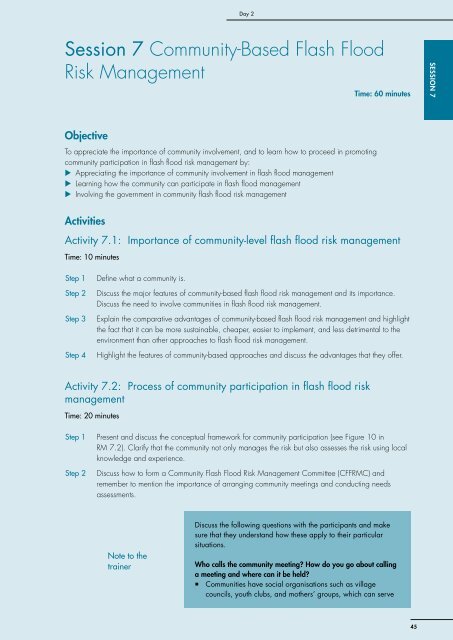Flash Flood Risk Management â A Training of Trainers ... - ReliefWeb
Flash Flood Risk Management â A Training of Trainers ... - ReliefWeb
Flash Flood Risk Management â A Training of Trainers ... - ReliefWeb
Create successful ePaper yourself
Turn your PDF publications into a flip-book with our unique Google optimized e-Paper software.
Day 2<br />
Session 7 Community-Based <strong>Flash</strong> <strong>Flood</strong><br />
<strong>Risk</strong> <strong>Management</strong><br />
Time: 60 minutes<br />
Session 7<br />
Objective<br />
To appreciate the importance <strong>of</strong> community involvement, and to learn how to proceed in promoting<br />
community participation in flash flood risk management by:<br />
XX<br />
Appreciating the importance <strong>of</strong> community involvement in flash flood management<br />
XX<br />
Learning how the community can participate in flash flood management<br />
XX<br />
Involving the government in community flash flood risk management<br />
Activities<br />
Activity 7.1: Importance <strong>of</strong> community-level flash flood risk management<br />
Time: 10 minutes<br />
Step 1<br />
Step 2<br />
Step 3<br />
Step 4<br />
Define what a community is.<br />
Discuss the major features <strong>of</strong> community-based flash flood risk management and its importance.<br />
Discuss the need to involve communities in flash flood risk management.<br />
Explain the comparative advantages <strong>of</strong> community-based flash flood risk management and highlight<br />
the fact that it can be more sustainable, cheaper, easier to implement, and less detrimental to the<br />
environment than other approaches to flash flood risk management.<br />
Highlight the features <strong>of</strong> community-based approaches and discuss the advantages that they <strong>of</strong>fer.<br />
Activity 7.2: Process <strong>of</strong> community participation in flash flood risk<br />
management<br />
Time: 20 minutes<br />
Step 1<br />
Step 2<br />
Present and discuss the conceptual framework for community participation (see Figure 10 in<br />
RM 7.2). Clarify that the community not only manages the risk but also assesses the risk using local<br />
knowledge and experience.<br />
Discuss how to form a Community <strong>Flash</strong> <strong>Flood</strong> <strong>Risk</strong> <strong>Management</strong> Committee (CFFRMC) and<br />
remember to mention the importance <strong>of</strong> arranging community meetings and conducting needs<br />
assessments.<br />
Note to the<br />
trainer<br />
Discuss the following questions with the participants and make<br />
sure that they understand how these apply to their particular<br />
situations.<br />
Who calls the community meeting? How do you go about calling<br />
a meeting and where can it be held?<br />
• Communities have social organisations such as village<br />
councils, youth clubs, and mothers’ groups, which can serve<br />
45

















